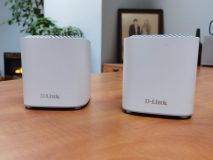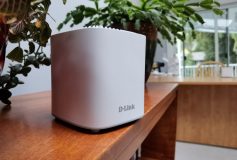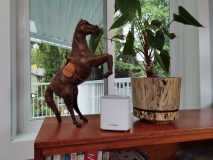
Since the advent of Wi-Fi, I’ve closely followed the evolution of wireless standards. In fact, listing the order of each standard is one of my favourite trivia questions to ask fellow technology enthusiasts.
Wi-Fi 6 aka “802.11ax” is the latest standard replacing Wi-Fi 5 “802.11ac”. In the next couple of years, many homes will upgrade to new wireless routers and home Wi-Fi systems that support Wi-Fi 6. As it stands, the problem preventing many people — myself included— is the price of new Wi-Fi 6 equipment. If you’re an early adopter of new wireless technology, you have to pay a pretty penny for the latest gear. Until today.
I’m reviewing the D-link Covr AX1800. Unlike most Wi-Fi 6 mesh systems, it hopes to introduce an affordable Wi-Fi 6 option. On the surface, this is great news. But is it any good? That’s where I come in. Through this review, I hope to answer those questions by assessing the setup, the smart features, and the overall wireless experience.
Notable specs of the Covr AX1800
- 4500 sq. ft. Wi-Fi coverage
- Dual-band with 574 Mbps (2.4GHz) + 1201 Mbps (5GHz)
- Two-gigabit ports for wired Ethernet connection options
- Voice and parental controls
Design of the Covr AX1800
Unlike some gaming routers with spaceship designs, the D-Link Covr AX1800 blends into the background. It comes with two small square-shaped units with rounded edges and a silver grille on top. It measures approximately 4” squared and fits on any table or bookshelf. It’s unassuming —I’m sure most people wouldn’t even notice it in a room.
The units are both identical, meaning there is no main router with additional mesh satellites. On the back are WAN and LAN ports. The WAN port is for the Internet connection. Only one of the units will be connected to the WAN port.
The LAN port can be used to connect a gaming console or laptop directly with an Ethernet connection. As great as Wi-Fi 6 is, my old rule of thumb still stands true. If you have the option for a direct, wired Ethernet connection, use it. It will always provide the most stable, reliable connection possible — even with Wi-Fi 6 mesh systems.
Setting up the Covr AX1800
Testing out new routers in my home can be tricky. I have a smart home with doors, lights, and thermostats connected to my Wi-Fi network. Therefore, I’m creating a secondary network to test out the Covr AX1800.
Like most mesh systems, the entire setup is done with an app. The D-link Wi-Fi app is available for iOS and Android. After downloading it, I logged into the default D-link Wi-Fi network by entering the password on the Quick Start Guide.
The instructions in the app are clear and easy to follow. It asks you to scan a QR code on the Quick Start Guide. From there, it does the rest of the work. It took me about 10 minutes to have both units up and running.
Wi-Fi network features
The D-Link Wi-Fi app provides users with a lot of control over their Wi-Fi network. First, it displays all the devices connected to a network. As a smart home owner, this is a valuable tool. I think most people would be surprised to know how many devices connect to their home Wi-Fi network.
Second, it gives quick access to pause the Internet with a single tap. If you ever wanted a quick way to get the kids to the dinner table, this is it. Parental controls give parents absolute control over access to the Wi-Fi network. I’m surprised more parents don’t use this feature. Here, parents can create individual profiles for each family member and their personal devices.
From there, they can set schedules for Internet access, and block websites on specific devices. This is a great way to stop the kids from accessing Instagram at night when they should be sleeping.
Using the Covr AX1800
I’m in the market for a Wi-Fi 6 mesh system so I tested the Covr AX1800 with my desired home setup for two units. I wanted to test its performance in those conditions.
I placed one unit in my living room and another inside my home studio. There’s a reason why I picked my home studio for the second unit. When I finally upgrade to Wi-Fi 6, I want to connect my laptop directly to a mesh satellite like the Covr AX1800 via Ethernet. This should provide my laptop with the strongest, most reliable connection to the Internet for live radio segments and Zoom meetings.
Once the Wi-Fi system was set up, I used an app to test the Wi-Fi signal strength around my house, and outside on my back deck.
As expected, standing near the unit in my living room provided 100% signal strength. In my home studio — where the second unit was located — the signal strength was 95%.
What surprised me was the signal strength on my back deck. It was hovering between 60-80%. Inside my back shed — located at the farthest point in my backyard — I was getting over 50% signal strength. What I noticed in each location was the signal strength would go down, but then suddenly go up. I suspect this is because of Smart Steering.
Smart Steering
One of the improved features of Wi-Fi 6 is Smart Steering. This technology encourages new devices to use the 5GHz network when applicable. It ensures dual-band devices like smartphones and tablets achieve peak performance based on their location in the Wi-Fi network.
For example, as I moved my device outside, Smart Steering switched my smartphone to the 2.4GHz network. That’s because the 2.4GHz network band has a longer wireless range than the 5GHz network. That explains why it went down, then up.
One thing I have not been able to figure out is if Wi-Fi 6 has increased the range of the 5GHz network. From what I can tell, it hasn’t. It would be great if we could one day ditch the 2.4GHz band altogether. But I was impressed with the outdoor signal strength, I didn’t think it would be that strong.
Final thoughts on the Covr AX1800
The question isn’t if you should upgrade to Wi-Fi 6, but when. As we add more and more devices to our home networks, Wi-Fi 6 technology ensures our devices have the best wireless performance possible.
The biggest roadblock for Wi-Fi 6 adoption has been the price. New Wi-Fi 6 mesh systems are expensive. The D-Link Covr AX1800 provides homeowners with an affordable Wi-Fi 6 option. Best of all, it’s a mesh system. That means you can always add additional units to expand your Wi-Fi network.
From my experiences, I think the majority of homes would be fine with the 2-pack. However, I would still want at least one more unit to expand the 5GHz network outside. Perhaps D-Link will make a dedicated Wi-Fi 6 unit for outdoor use in the near future. That’s what I’m looking for before I make the switch.
As new Wi-Fi 6 systems enter the market, I’ve been telling people to purchase older Wi-Fi 5 mesh systems because they’re more affordable. However, I think I will now be recommending people consider the D-Link Covr AX1800. At this price point, it gives you Wi-Fi 6 technology, excellent range, and it will future-proof your wireless network for years to come.








Update Decided to try it again and it’s working. With 5 g. I just needed a new router as the button is 10 years old and spotty internet. We shall see how it works. It did speed up internet
Didn’t work for me advertised at set up to use your same name only gave 2.4 GHz tried to get back into settings. I decided to try it again and it’s working time will tell I guess
Didn’t work for me advertised at set up to use your same name only gave 2.4 GHz tried to get back into settings and it would not allow me to get back in the router. Reset it and everything. Taking it back
Comments are closed.